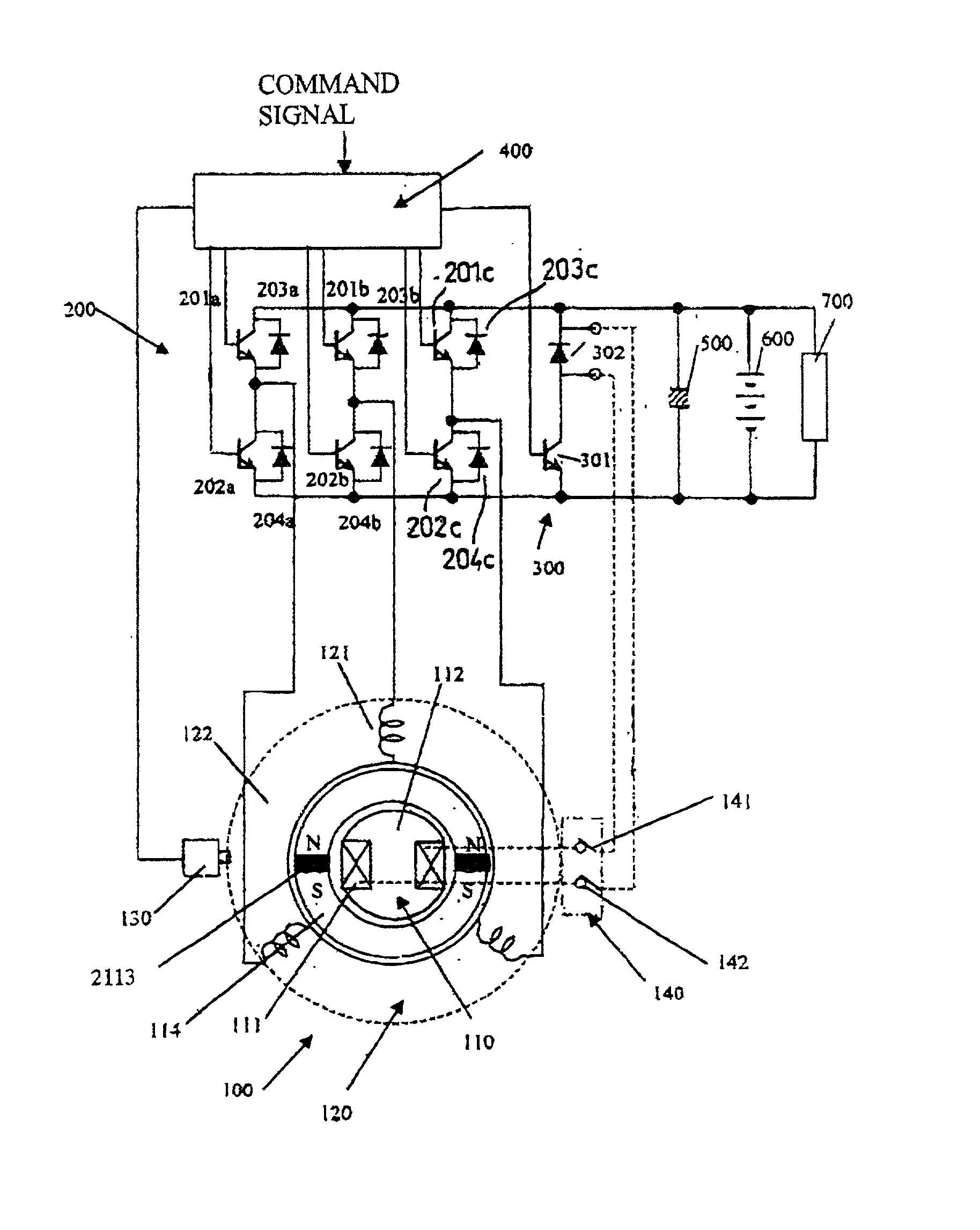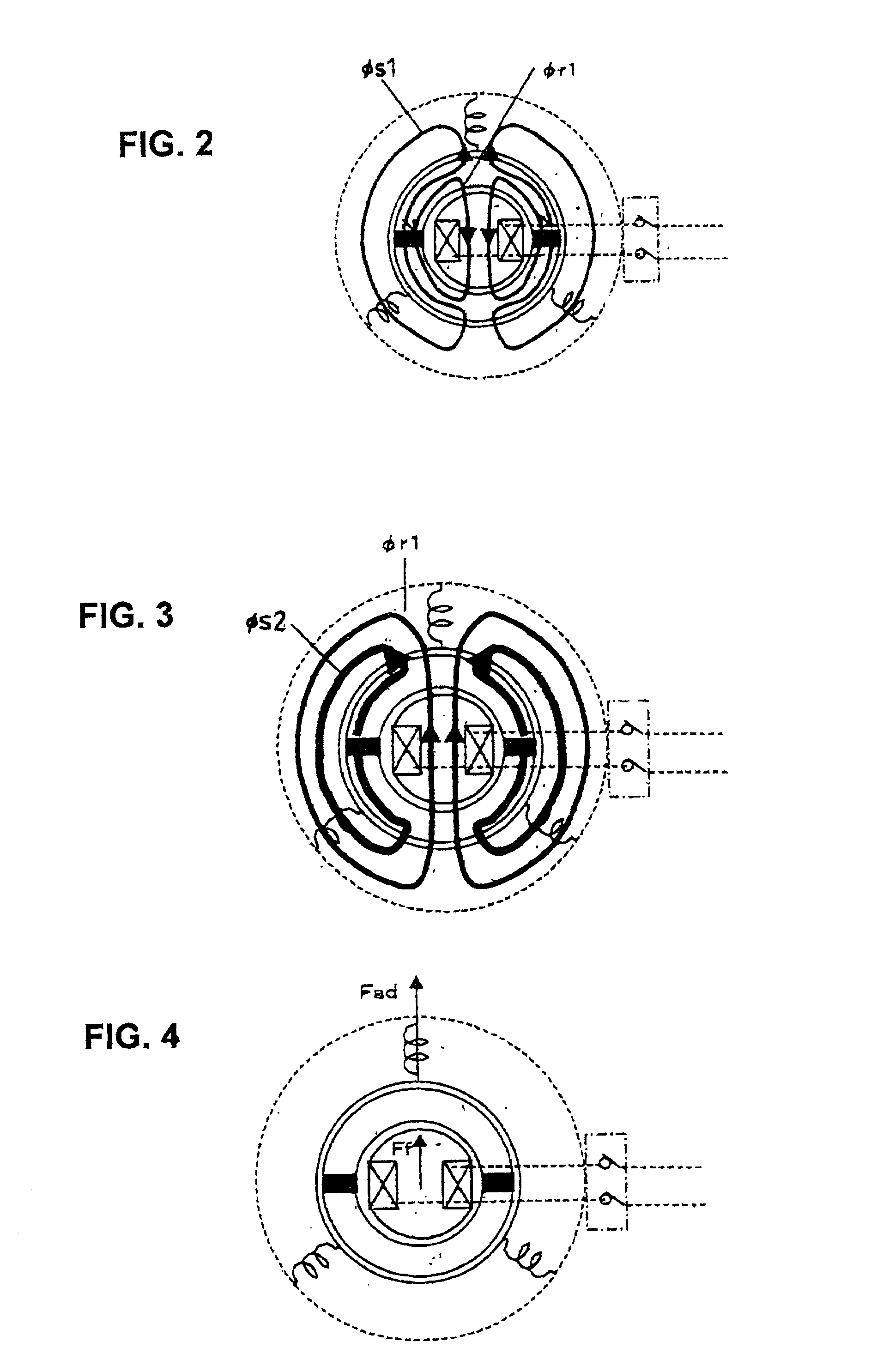Vehicle motor-generator apparatus utilizing synchronous machine having field winding
- Summary
- Abstract
- Description
- Claims
- Application Information
AI Technical Summary
Benefits of technology
Problems solved by technology
Method used
Image
Examples
first embodiment
[0067] FIG. 1 shows the overall configuration of a vehicle motor-generator apparatus according to the present invention. This is based on a synchronous machine 100 functioning as a generator-motor, which has both permanent magnets and a field winding. The synchronous machine 100 has a rotor 110 disposed within the inner periphery of a stator 120. The rotor 110 has a first rotor core 112 with a field winding 111 wound thereon, and a second rotor core 114 mounted coaxially with the first rotor core 112 such as to be incapable of rotation with respect to the first rotor core 112, and having permanent magnets 2113 mounted thereon. The rotor 110 is mechanically coupled to the crankshaft of a vehicle engine (not shown in the drawings) by for example a drive belt.
[0068] The stator 120 has a stator core 122 with an inner periphery which is separated by a fixed gap from the outer periphery of the second rotor core 114, and which has a 3-phase armature winding 121 wound thereon. The synchrono...
second embodiment
[0080] A second embodiment will be described, whose overall configuration is as shown in FIG. 5. This configuration differs from that of the preceding embodiment only with respect to the rotor 110 of the synchronous machine 2000, which is not provided with permanent magnets. However it should be understood that the principles described in the following would also apply to a synchronous machine having a field winding and permanent magnets mounted on the rotor.
[0081] The operation of this embodiment with respect to engine starting will be described referring to FIG. 11. Firstly, when engine starting is to be executed by the synchronous machine 2000, power is supplied from the field current supply circuit 300 to the field winding 111, and a field magnetizing force Ff is thereby generated whereby the rotor 110 is magnetized and a field flux .phi.f is thereby induced in the stator 120. Since the field winding 111 has a high value of inductance, a certain amount of time is required before...
third embodiment
[0100] A third embodiment will be described referring to FIG. 13. The overall configuration of the vehicle motor-generator apparatus can be as described for either of the preceding embodiments, so that detailed description will be omitted.
[0101] As can be understood from the description of the preceding embodiment, it is important to have a large value of thermal capacity Q of the rotor of a field winding type of synchronous machine which is used as a vehicle motor-generator. However, a large thermal capacity signifies that the rotor must be large in size. An embodiment will be described whereby thermal transfer is increased between the field winding 111 and the armature winding 121, i.e., whereby the temperature differential between these is reduced. The effective thermal capacity of the armature winding 121 can thereby be increased. FIG. 13 is a partial cross-sectional view of the rotor of the synchronous machine of this embodiment. As shown, the field winding 111 is held within a...
PUM
 Login to View More
Login to View More Abstract
Description
Claims
Application Information
 Login to View More
Login to View More - R&D
- Intellectual Property
- Life Sciences
- Materials
- Tech Scout
- Unparalleled Data Quality
- Higher Quality Content
- 60% Fewer Hallucinations
Browse by: Latest US Patents, China's latest patents, Technical Efficacy Thesaurus, Application Domain, Technology Topic, Popular Technical Reports.
© 2025 PatSnap. All rights reserved.Legal|Privacy policy|Modern Slavery Act Transparency Statement|Sitemap|About US| Contact US: help@patsnap.com



